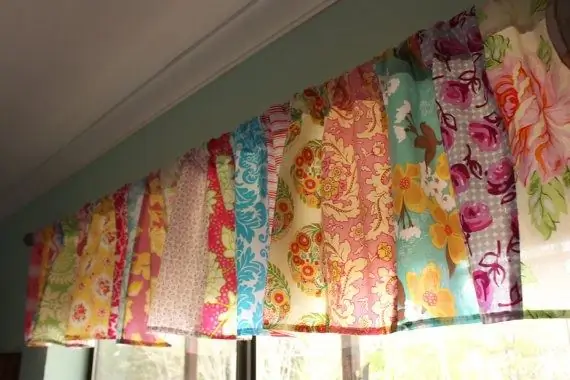Decorative patchwork can be compared to painting, only the paint is replaced by the fabric, and the brushes are replaced by a needle and thread. If old things or scraps of fabric have accumulated in the closet, do not rush to throw them away, you can make original interior items from them, for example, curtains.

Preparation for work
For the manufacture of curtains in the patchwork style, you can use a variety of fabrics - thin and dense, colored and monochromatic, with a printed or embossed pattern. The choice of pattern and texture of the canvas depends on the author's intention and on the interior in which the curtains will hang.
For work, in addition to matter, you will need measuring instruments: transparent rulers of different lengths, a compass and a right-angled triangle, a special ruler on which a coordinate grid is applied. A patchwork product looks spectacular if the details are cut with millimeter precision. Before work, the shreds must be re-sorted, washed and ironed.
Curtain making technique
The patchwork technique involves making curtains from pieces of fabric arranged in a certain way and forming an ornament. In order to properly lay the flaps, prepare a sketch of the diagram on graph paper. Better to make it life-size, but you can also scale it.
The pattern can be composed of elements of the same shape and size. In this case, you need to cut out a template from thick paper and cut the fabric along it. Details of the scheme are cut out taking into account the seam allowances. Curtains can be "put" on the lining to close the seams from the inside out, or you can make single-layer curtains and then the seams will have to be additionally processed. To create a heavy, dense fabric, it is more convenient to sew patchwork blocks onto the base.
After the completion of the preparatory work, the first two parts of the fragment are folded with the front sides inward, aligned along the cuts and grinded with a straight stitch seam and additionally with a zigzag seam. The seams are ironed out, the following elements are sewn in the same way. Put the assembled block on the sketch, cut off the excess along the edge, iron it out.
In the same way, prepare the required number of such fragments and combine them into a canvas. Seams on the seamy side can be decorated with braid, cords, ribbons, decorative stitches.
Parquet layout
There are several modules that make up the picture: parquet, hut, Russian square, diagonal, diamond, pineapple and others. The simplest and most popular type of patchwork sewing is the creation of an ornament from stripes, this pattern is called "parquet".
The "parquet" module is assembled from square blocks, which are sewn as follows: the basis of the scheme is a square - a strip of arbitrary width is attached to it, the same rectangle is laid on the adjacent side and sewn. Continue sewing the strips on both sides. The tiers can be of different widths. Different schemes can be assembled from the same fragments.






